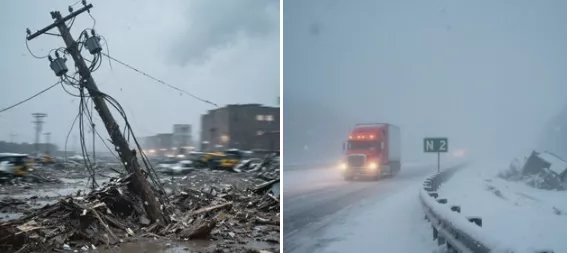
A severe snow and windstorm recently swept across parts of South Africa, resulting in tragic consequences and widespread disruption. The powerful storm, which brought rare snowfall to some regions alongside strong, gusty winds, has claimed at least 49 lives and caused significant damage to infrastructure.
The unusual weather event affected mainly the highland and mountainous areas in the eastern and southern parts of the country, including provinces such as KwaZulu-Natal, Eastern Cape, and parts of the Drakensberg Mountains. Meteorological stations recorded snowfall accumulation between 5 and 15 cm above 1,000 meters elevation, an uncommon occurrence for early June.
Strong winds accompanied the snowfall, with gusts reaching 70 to 90 km/h in exposed mountain passes and ridges. These high winds, combined with snow, created blizzard-like conditions, significantly reducing visibility to below 100 meters in some areas.
Temperatures plummeted to near or below freezing, with some locations reporting lows of -5°C at higher altitudes, exacerbating the dangerous conditions. Daytime temperatures in affected valleys hovered between 0 and 3°C, unusually cold for the season.
The combination of heavy snow, freezing temperatures, and high winds led to multiple road closures due to icy surfaces and fallen trees, as well as widespread power outages caused by wind damage to electrical infrastructure.
Emergency services were stretched as multiple traffic accidents and incidents of hypothermia were reported. Tragically, the storm resulted in at least 49 fatalities, mostly linked to vehicle crashes on icy roads and exposure to cold in vulnerable communities.
Authorities had issued weather warnings several days prior, highlighting the threat of severe winter weather and advising caution. Despite these efforts, the storm’s intensity and rapid development caught some residents unprepared, particularly in regions less accustomed to snow.
Meteorologists note that while snow is not unprecedented in South Africa’s mountain regions, the extent and severity of this storm are notable for this time of year. This event is part of a broader pattern of increasing weather extremes observed in southern Africa, possibly influenced by global climate change and shifts in atmospheric circulation patterns.

Illustration picture: https://x.com/Moji_weather/status/1932680651909845077



























2 thoughts on “Snow- and Windstorm left 49 dead in South Africa”
Comments are closed.